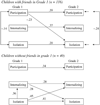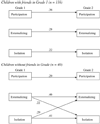Friendship moderates prospective associations between social isolation and adjustment problems in young children
- PMID: 17650145
- PMCID: PMC2754761
- DOI: 10.1111/j.1467-8624.2007.01072.x
Friendship moderates prospective associations between social isolation and adjustment problems in young children
Abstract
This longitudinal study investigated prospective links between social isolation and adjustment problems among 166 (77 girls, 89 boys) Finnish children ages 7 to 9. Peer nominations for social engagement and self-reports of internalizing and externalizing problems were collected in the spring of the 1st and 2nd grade. Friendship moderated prospective associations between peer and adjustment variables. Among friended children, there were no prospective associations between social isolation and either internalizing or externalizing problems. Among unfriended children, initial social isolation was positively linked to subsequent increases in internalizing and externalizing problems, and initial internalizing and externalizing problems predicted subsequent increases in social isolation. The findings suggest that friendship buffers against the adverse consequences associated with being isolated and presenting adjustment difficulties.
Figures


Similar articles
-
The role of chronic peer difficulties in the development of children's psychological adjustment problems.Child Dev. 2003 Sep-Oct;74(5):1344-67. doi: 10.1111/1467-8624.00611. Child Dev. 2003. PMID: 14552402
-
The timing of middle-childhood peer rejection and friendship: linking early behavior to early-adolescent adjustment.Child Dev. 2007 Jul-Aug;78(4):1037-51. doi: 10.1111/j.1467-8624.2007.01051.x. Child Dev. 2007. PMID: 17650124
-
The role of peer relationships in the development of early school-age externalizing problems.Child Dev. 2011 May-Jun;82(3):758-65. doi: 10.1111/j.1467-8624.2010.01532.x. Epub 2011 Mar 9. Child Dev. 2011. PMID: 21410917 Clinical Trial.
-
Child executive function and future externalizing and internalizing problems: A meta-analysis of prospective longitudinal studies.Clin Psychol Rev. 2022 Nov;97:102194. doi: 10.1016/j.cpr.2022.102194. Epub 2022 Aug 8. Clin Psychol Rev. 2022. PMID: 35964337 Review.
-
Emotion-related self-regulation and its relation to children's maladjustment.Annu Rev Clin Psychol. 2010;6:495-525. doi: 10.1146/annurev.clinpsy.121208.131208. Annu Rev Clin Psychol. 2010. PMID: 20192797 Free PMC article. Review.
Cited by
-
Revisiting the hypothesis that friends buffer against diminished self-esteem arising from poor quality parent-adolescent relationships: A replication study.Dev Psychol. 2021 Dec;57(12):2067-2081. doi: 10.1037/dev0001119. Dev Psychol. 2021. PMID: 34928659 Free PMC article.
-
Emotion-related socialization in the classroom: Considering the roles of teachers, peers, and the classroom context.Dev Psychol. 2020 Mar;56(3):578-594. doi: 10.1037/dev0000863. Dev Psychol. 2020. PMID: 32077726 Free PMC article. Review.
-
PROTOCOL: Video-based interventions for promoting positive social behaviour in children with autism spectrum disorders: a systematic review and meta-analysis.Campbell Syst Rev. 2021 May 24;17(2):e1171. doi: 10.1002/cl2.1171. eCollection 2021 Jun. Campbell Syst Rev. 2021. PMID: 37051174 Free PMC article.
-
Paternal Incarceration and Adolescent Social Network Disadvantage.Demography. 2017 Aug;54(4):1477-1501. doi: 10.1007/s13524-017-0589-8. Demography. 2017. PMID: 28702934
-
Social isolation and mental health at primary and secondary school entry: a longitudinal cohort study.J Am Acad Child Adolesc Psychiatry. 2015 Mar;54(3):225-32. doi: 10.1016/j.jaac.2014.12.008. Epub 2014 Dec 24. J Am Acad Child Adolesc Psychiatry. 2015. PMID: 25721188 Free PMC article.
References
-
- Aunola K, Nurmi J-E. Maternal affection moderates the impact of psychological control on a child’s mathematical performance. Developmental Psychology. 2004;40:965–978. - PubMed
-
- Aunola K, Nurmi J-E. The role of parenting styles in children’s problem behavior. Child Development. 2005;76:1144–1159. - PubMed
-
- Bentler PM. EQS structural equations program manual. Encino, CA: Multivariate Software; 1995.
-
- Berndt TJ. Children’s friendships: Shifts over a half-century in perspectives on their development and their effects. Merrill-Palmer Quarterly. 2004;50:206–223.
-
- Bierman KL. Peer rejection: Developmental processes and interventions. New York: Guilford; 2003.
Publication types
MeSH terms
Grants and funding
LinkOut - more resources
Full Text Sources

